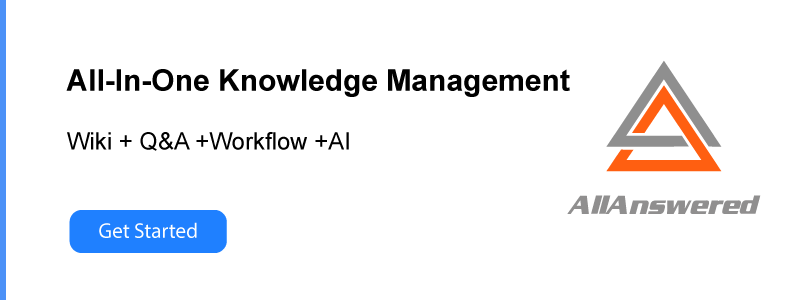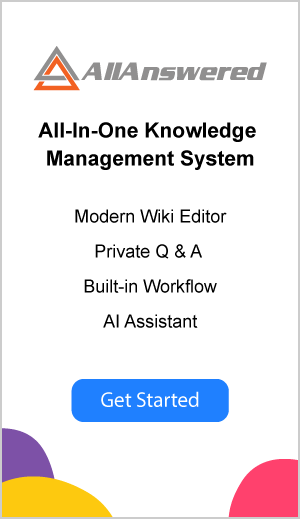4 Strategies for Creating an Effective Knowledge Transfer Plan
Let’s start by defining what a Knowledge Transfer Plan is. ‘Knowledge Transfer’ is both a theoretical and practical method of sharing information, ideas, and abilities across different areas of a business for maximum efficiency. While it can be about preparing for a key employee’s imminent departure, it’s also about creating a workable plan for sharing knowledge today, to develop a more informed and collaborative workforce. A Knowledge Transfer Plan is an ongoing business strategy with quantifiable results.
What Should Be Included in a Knowledge Transfer Plan?
There are 2 types of knowledge, tacit and explicit; both of which are involved in Knowledge Transfer Plans. So, what’s the difference between the two?
Tacit knowledge is developed through a person’s observations, experiences, and insights, so this kind of knowledge is difficult to pass on or transfer through verbalization or writing. The knowledge is typically imparted or transferred through shared activities.
Explicit knowledge can easily be picked up from looking something up online, reading a book, or talking to someone, so this kind of knowledge is easily shared and transferred through speaking or writing.
So, while both tacit and explicit knowledge play a role in Knowledge Transfer, the most difficult and perhaps most important type to obtain is tacit knowledge, simply because, to acquire this knowledge, more effort and interaction are required.
With today's fast pace, people are changing jobs on a regular basis. More-and-more we’re seeing valued team members leaving businesses, taking with them all their valuable insights and information accrued during their tenure.
Not only is knowledge lost when an employee leaves an organization, it can also be a problem when personnel are working remotely. Let’s say a key employee has huge amounts of information stored either in their head or on a hard drive: if they’re off-line when needed by other staff members, that information is not available to them in real-time.
Regardless of whether a staff member is leaving through employment with another firm, retirement, or remote work, the end result is still the same – when that person leaves, everything they know leaves with them. With no way of transferring or retaining that knowledge, an organization can be left in a difficult situation. They must now train a new employee whilst still maintaining an uninterrupted level of customer service.
Knowledge Transfer Plans Provide a Strong Foundation for Streamlining Personnel Changes
It’s now become imperative that organizations have a workable Knowledge Transfer Plan in place. The best and most effective Knowledge Transfer Plan will include ways to include tacit and explicit knowledge.
Having a reliable Knowledge Transfer Plan will ensure there’s no knowledge loss when employees leave. It’s also the ideal way of establishing a knowledge database of company information, enabling on-site, remote, new, and experienced employees to have easy access to updated company knowledge. And the bonus will be boosted productivity, because the amount of time employees spend searching through files and emails for the information they require will be dramatically reduced.
How to Create a Workable Knowledge Transfer Plan
A Knowledge Transfer Plan doesn’t have to be complicated. All that’s required is a consistent step-by-step strategy for gathering knowledge and transferring that same knowledge to those who need it. Below we’ve listed our 4 key steps to creating a workable Knowledge Transfer Plan for your business.
No. 1: Determine the Kinds of Information You Want to Retain
If you’ve never considered a Knowledge Transfer Plan for your business, this is the perfect time for you to decide what kinds of information should be available to your team members, and how that information can be captured and access provided.
Start by considering the kinds of information that are helpful to people every day. It may be something simple like how a customer service call should be logged in your CRM, or it may be more complex information like your business strategy for responding to difficult customers during the sales process. Identifying these types of information ensures your company stays protected from knowledge loss. Ask yourself the following questions –
- If your most valued and knowledgeable employee were suddenly to give notice that they were leaving your employ, what knowledge of theirs would you want to capture?
- In what areas does your business face the most potential loss of knowledge?
- How much knowledge needs to be captured?
- Who are the go-to people in your business who have this knowledge?
- What tasks pile up when these staff members are away because no one else knows how to fill their role?
- If these people left today, do other staff members know how to complete their duties?
- How can critical knowledge be captured, then transferred to those who require it?
Now that you’ve identified the goals for capturing knowledge, you’re ready to start developing a plan of action.
No. 2: Create a Process for Obtaining the Necessary Knowledge
To start with, you need to determine the types of knowledge that need to be captured; however, at the same time, you should be considering how this information will be saved. The answer to that question will be simple for some types of information, like Excel spreadsheets, Word documents, and PowerPoint presentations – these can all be saved in their original format - but it won’t be possible to document all company knowledge in these types of formats.
Let’s say you’d like to record customer service calls to assist future employees in handling complex customer service issues. That knowledge could be saved by recording these phone conversations and saving them as audio-files. Similarly, it may be effective to save some types of information as chat or video transcripts. Perhaps some knowledge will need to be saved in a combination of rich media types, like graphs, videos, images, and so on, to ensure the necessary context is provided.
The only way you’re going to ensure your company is capturing and retaining critical knowledge in a useful format is to empower your employees by giving them a Knowledge Transfer Plan to follow. This would include detailed instructions on how, where, and when information should be saved.
There must be uniformity within your business on how knowledge is saved, otherwise, you could find that someone on your market research team documents every detail precisely and methodically while another employee documents only a minimal amount of information and relies mostly on their memory.
It’s up to you as a business owner or manager to ensure that all employees receive specific guidance on what types of information to save and how to save it. Make it a priority to invest your effort and time in creating a uniform process that allows for seamless and reliable knowledge transfer.
No. 3: Choose the Technology to Enable Knowledge Transfer
Now that you’ve determined the types of information you want to preserve, you need to decide the appropriate technology formats that will assist in supporting your goals. Unfortunately, many companies fail in their attempts to preserve knowledge simply because employees are put in charge of deciding what information should be saved, with management failing to provide guidance for that process. Employees are instructed to rely on tools like SharePoint or Google Drive, which can very quickly lead to confusion and disorganization.
On the positive side, using technology for knowledge sharing that’s easy to use and requires little effort, removes most obstacles to the successful transfer of company knowledge. The right knowledge-sharing platform for your business will eliminate human differences and preferences out of the equation and enable you to automate and standardize how information is stored.
Because you’ll have many different employees sharing and saving information, your technology tool should also ensure that duplicate and outdated content is identified and the most current version is available to employees. Ideally, the knowledge-sharing platform you choose will ensure that both tacit knowledge and explicit knowledge are captured using Q&As and documentation tools such as Wiki.
No. 4: Your Knowledge Transfer Plan Must Reflect the Ever Growing and Evolving Knowledge within Your Company
Having a Knowledge Transfer Plan in place is just the first strategy for ongoing knowledge sharing; now you need to empower your employees to use this knowledge transfer to its full potential. In addition to saving and documenting information, your employees should be encouraged to use the Knowledge Transfer system on a daily basis, to locate whatever information they may require.
Ensure your system includes powerful search and Q&A features, which will empower your employees to use the system instead of having to ask the same questions over and over again of subject matter experts.
The right knowledge-sharing platform for your business can also be helpful in providing support and keeping knowledge current when existing personnel leave your employ. Ideally, your knowledge-sharing platform will support –
- Collaboration: Your employees will now have tools that allow multiple employees to collaborate on information with each other across multiple locations in real-time.
- Workflow: Your platform should provide integrated workflow so that tasks can be created to keep content updated and the knowledge base fresh.
- Communities: Your platform will provide virtual spaces allowing employees to meet and share best practices and other experiences, all of which ultimately become part of the knowledge base.
In Conclusion
Start today, by thinking about the types of knowledge you want to be preserved, and the specific technology you believe will help you achieve that goal. AllAnswered all-in-one knowledge management system helps teams, big or small, build a solid knowledge transfer plan and an effective knowledge base. Don’t wait for your next employee to leave and take with them all the invaluable information they’ve learned during their period of employment with your company.








